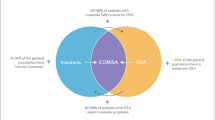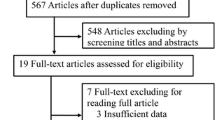Abstract
Background
Obstructive sleep apnoea is recognised as a common but under-diagnosed health issue. Currently, there is very little published data relating to the burden and impact of obstructive sleep apnoea among indigenous populations. The purpose of this review was to investigate the prevalence, impact, risk factors and treatment of obstructive sleep apnoea in indigenous populations in high-income countries.
Methods
An integrative review was conducted on 25 English language studies and reports that investigated obstructive sleep apnoea among indigenous populations in high-income countries. Studies that did not focus on indigenous populations in the results or discussion were excluded. Eligible studies were identified by searching PubMed, Web of Science and Google Scholar databases and reference lists of eligible studies. Publication dates range from 1998 to 2012.
Results
Synthesis of studies indicates the prevalence of obstructive sleep apnoea is higher and severity is greater in indigenous populations compared with non-indigenous populations. Comparable risk factors for obstructive sleep apnoea were identified in indigenous and non-indigenous populations, with only three studies identifying ethnicity as an independent risk factor.
Conclusions
Indigenous populations in high-income countries are subject to an overall greater prevalence of obstructive sleep apnoea that is also more severe. A higher prevalence of obesity, alcohol and tobacco use and comorbid medical conditions associated with low socioeconomic status rather than indigenous status per se appears to explain this disparity.

Similar content being viewed by others
References
American Psychiatric Association (2000) Diagnostic and statistical manual of mental disorders: DSM-IV-TR® American Psychiatric Pub.
American Academy of Sleep Medicine (2001) International classification of sleep disorders, revised: diagnostic and coding manual. American Academy of Sleep Medicine, Chicago, Illinois
Ring I, Brown N (2003) The health status of indigenous peoples and others: the gap is narrowing in the United States, Canada, and New Zealand, but a lot more is needed. BMJ 327:404–405
Peppard P, Young T, Palta M, Skatrug J (2000) Prospective study of the association between sleep-disordered breathing and hypertension. New Engl J Med 342:1378–1384
Young T, Peppard PE, Gottlieb DJ (2002) Epidemiology of obstructive sleep apnea: a population health perspective. Am J Resp Crit Care Med 165:1217–1239
Peker Y, Carlson J, Hedner J (2006) Increased incidence of coronary artery disease in sleep apnoea: a long-term follow-up. Eur Respir J 28:596–602
Reichmuth KJ, Austin D, Skatrud JB, Young T (2005) Association of sleep apnea and type II diabetes: a population-based study. Am J Resp Crit Care Med 172:1590–1595
Peppard PE, Szklo-Coxe M, Hla KM, Young T (2006) Longitudinal association of sleep-related breathing disorder and depression. Arch Intern Med 166:1709–1715
Redline S, Yenokyan G, Gottlieb DJ et al (2010) Obstructive sleep apnea–hypopnea and incident stroke: the sleep heart health study. Am J Resp Crit Care Med 182:269–277
Shah NA, Yaggi HK, Concato J, Mohsenin V (2010) Obstructive sleep apnea as a risk factor for coronary events or cardiovascular death. Sleep Breath 14:131–136
Shahar E, Whitney CW, Redline S et al (2001) Sleep-disordered breathing and cardiovascular disease: cross-sectional results of the Sleep Heart Health Study. Am J Resp Crit Care Med 163:19–25
Hiestand DM, Britz P, Goldman M, Phillips B (2006) Prevalence of symptoms and risk of sleep apnea in the US population: results from the National Sleep Foundation Sleep in America 2005 Poll. CHEST J 130:780–786
Economics DA (2011) Reawakening Australia: the economic cost of sleep disorders in Australia, 2010. Sleep Health Foundation, Canberra
Baldwin CM, Ervin A-M, Mays MZ et al (2010) Sleep disturbances, quality of life, and ethnicity: the Sleep Heart Health Study. J Clin Sleep Med 6:176–183
Redline S, Tishler PV (2000) The genetics of sleep apnea. Sleep Med Rev 4:583–602
Villaneuva AT, Buchanan PR, Yee BJ, Grunstein RR (2005) Ethnicity and obstructive sleep apnoea. Sleep Med Rev 9:419–436
Adams R, Appleton S, Vakulin A et al (2012) High prevalence of undiagnosed OSA in a community sample of men aged 40 years and over. Sleep Biol Rhythms 10:42
Mihaere KM, Harris R, Gander PH, et al (2009) Obstructive sleep apnea in New Zealand adults: prevalence and risk factors among Maori and non-Maori. Sleep 32:949–956
Whittemore R, Knafl K (2005) The integrative review: updated methodology. J Adv Nurs 52:546–553
Burls A (2009) Critical Appraisal Skills Programme: making sense of evidence. http://www.casp-uk.net/. Accessed 11 May 2013.
Moher D, Liberati A, Tetzlaff J, Altman D, Group TP (2009) Preferred reporting items for systematic reviews and meta-analyses: the PRISMA statement. PLoS Med 6:e1000097
Young T, Shahar E, Redline S et al (2002) Predictors of sleep-disordered breathing in community-dwelling adults: the Sleep Heart Health Study. Arch Intern Med 162:893–900
Kapur V, Strohl KP, Redline S, Iber C, O’Connor G, Nieto J (2002) Underdiagnosis of sleep apnea syndrome in US communities. Sleep Breath 6:49–54
O’Connor GT, Lind BK, Lee ET, et al (2003) Variation in symptoms of sleep-disordered breathing with race and ethnicity: the Sleep Heart Health Study. Sleep 26:74–79
Redline S, Kirchner HL, Quan SF, Gottlieb DJ, Kapur V, Newman A (2004) The effects of age, sex, ethnicity, and sleep-disordered breathing on sleep architecture. Arch Intern Med 164:406–418
Froese CL, Butt A, Mulgrew A et al (2008) Depression and sleep-related symptoms in an adult, indigenous, North American population. J Clin Sleep Med 4:356–361
Wesche S, Ryan R, Carry C (2011) First Nations. Respiratory Health Initiatives Environmental Scan. Ottawa, National Aboriginal Health Organization, Inuit and Métis
Bakker JP, O’Keeffe KM, Neill AM, Campbell AJ (2011) Ethnic disparities in CPAP adherence in New Zealand: effects of socioeconomic status, health literacy and self-efficacy. Sleep 34:1595–1603
Baldwin DR, Kolbe J, Troy K et al (1998) Comparative clinical and physiological features of Maori, Pacific Islanders and Europeans with sleep related breathing disorders. Respirology 3:253–260
Campbell A, Neill A, Lory R (2012) Ethnicity and socioeconomic status predict initial continuous positive airway pressure compliance in New Zealand adults with obstructive sleep apnoea. Intern Med J 42:e95–e101
Coltman R, Taylor DR, Whyte K, Harkness M (2000) Craniofacial form and obstructive sleep apnea in Polynesian and Caucasian men. Sleep 23:943–950
Ferrier K, Campbell A, Yee B et al (2005) Sleep-disordered breathing occurs frequently in stable outpatients with congestive heart failure. CHEST J 128:2116–2122
Firestone RT, Mihaere K, Gander PH (2009) Obstructive sleep apnoea among professional taxi drivers: a pilot study. Accid Anal Prev 41:552–556
Firestone RT, Gander PH (2004) Exploring knowledge and attitudes of taxi drivers with regard to obstructive sleep apnoea syndrome. N Z Med J 123:24–33
Gander PH, Marshall NS, Harris RB, Reid P (2005) Sleep, sleepiness and motor vehicle accidents: a national survey. Aust N Z J Public Health 29:16–21
Gander PH, Marshall NS, Harris R, Reid P (2005) The Epworth Sleepiness Scale: influence of age, ethnicity, and socioeconomic deprivation. Epworth Sleepiness scores of adults in New Zealand. Sleep 28:249–253
Hancox RJ, Whyte KF, Baxter JM (2000) Home ventilation: the Green Lane Hospital experience. N Z Med J 113:500–503
O’Grady K-AF, Revell A, Maguire GP et al (2011) Lung health care for Aboriginal and Torres Strait Islander Queenslanders: breathing easy is not so easy. Aust Health Rev 35:512–519
Thoracic Society of Australia and New Zealand, Australasian Sleep Association, Australian Lung Foundation [Report] (2010) Respiratory and sleep health in indigenous Australians. Thoracic Society of Australia and New Zealand, Sydney
Horne J, Reyner L (1999) Vehicle accidents related to sleep: a review. Occup Environ Med 56:289–294
Connor J, Norton R, Ameratunga S et al (2002) Driver sleepiness and risk of serious injury to car occupants: population based case control study. BMJ 324:1125–1129
George C (2004) Sleep 5: driving and automobile crashes in patients with obstructive sleep apnoea/hypopnoea syndrome. Thorax 59:804–807
Howard ME, Desai AV, Grunstein RR et al (2004) Sleepiness, sleep-disordered breathing, and accident risk factors in commercial vehicle drivers. Am J Resp Crit Care Med 170:1014–1021
Dagan Y, Doljansky JT, Green A, Weiner A (2006) Body mass index (BMI) as a first-line screening criterion for detection of excessive daytime sleepiness among professional drivers. Traffic Inj Prev 7:44–48
Vennelle M, Engleman HM, Douglas NJ (2010) Sleepiness and sleep-related accidents in commercial bus drivers. Sleep Breath 14:39–42
Young T, Skatrud J, Peppard PE (2004) Risk factors for obstructive sleep apnea in adults. JAMA 291:2013–2016
Centres for Disease Control and Prevention (2008) Perceived insufficient rest or sleep—four states, 2006. MMWR Morb Mortal Wkly Rep 57:200–203. http://www.cdc.gov/mmwr/preview/mmwrhtml/mm5708a2.htm. Accessed 18 May 2013.
Conflict of interest
No conflict of interest has been declared by the authors.
Author information
Authors and Affiliations
Corresponding author
Rights and permissions
About this article
Cite this article
Woods, C.E., Usher, K. & Maguire, G.P. Obstructive sleep apnoea in adult indigenous populations in high-income countries: an integrative review. Sleep Breath 19, 45–53 (2015). https://doi.org/10.1007/s11325-014-1032-7
Received:
Revised:
Accepted:
Published:
Issue Date:
DOI: https://doi.org/10.1007/s11325-014-1032-7




